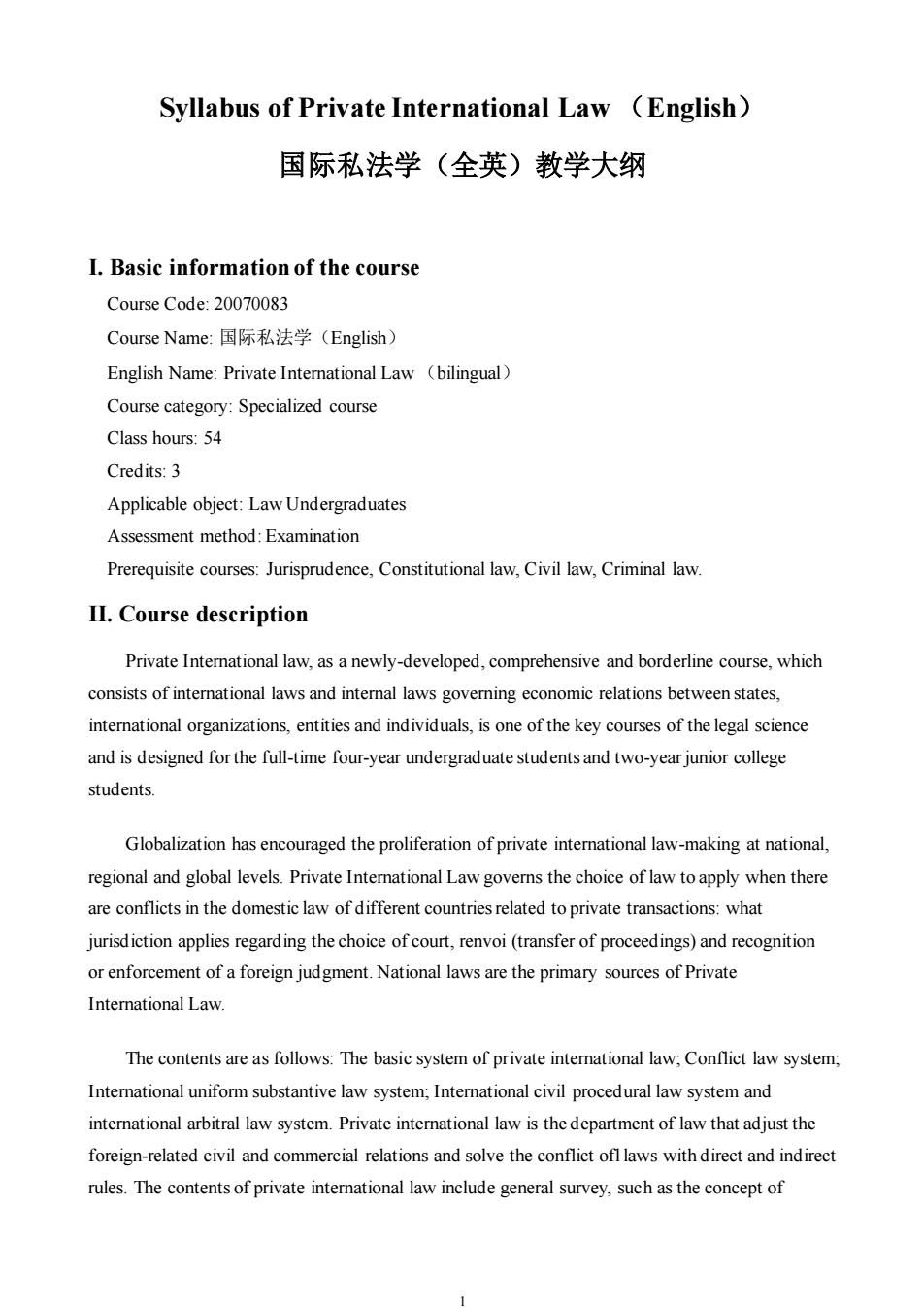
Syllabus of Private International Law (English) 国际私法学(全英)教学大纲 I.Basic information of the course Course Code:20070083 Course Name::国际私法学(English) English Name:Private International Law (bilingual) Course category:Specialized course Class hours:54 Credits:3 Applicable object:Law Undergraduates Assessment method:Examination Prerequisite courses:Jurisprudence,Constitutional law,Civil law,Criminal law II.Course description Private Intemational law,as a newly-developed,comprehensive and borderline course,which consists of international laws and intemal laws govering economic relations between states. intemational organizations,entities and individuals,is one of the key courses of the legal scienc and is designed for the full-time four-year undergraduate students and two-year junior college students. Globalization has encouraged the proliferation of private international law-making at national, regional and global levels.Private International Law governs the choice of law to apply when there are conflicts in the domestic law of different countries related to private transactions:what jurisdiction applies regarding the choice of court,renvoi (transfer of proceedings)and recognition or enforcement of a foreign judgment.National laws are the primary sources of Private The contents are as follows:The basic system of private intemational law,Conflict law system Intemational uniform substantive law system:Intemational civil procedural law system and interational arbitral law system.Private intemational law is the department of law that adjust the foreign-related civil and commercial relations and solve the conflict ofl laws withdirect and indirect rules.The contents of private international law include general survey,such as the concept of
1 Syllabus of Private International Law (English) 国际私法学(全英)教学大纲 I. Basic information of the course Course Code: 20070083 Course Name: 国际私法学(English) English Name: Private International Law (bilingual) Course category: Specialized course Class hours: 54 Credits: 3 Applicable object: Law Undergraduates Assessment method: Examination Prerequisite courses: Jurisprudence, Constitutional law, Civil law, Criminal law. II. Course description Private International law, as a newly-developed, comprehensive and borderline course, which consists of international laws and internal laws governing economic relations between states, international organizations, entities and individuals, is one of the key courses of the legal science and is designed for the full-time four-year undergraduate students and two-year junior college students. Globalization has encouraged the proliferation of private international law-making at national, regional and global levels. Private International Law governs the choice of law to apply when there are conflicts in the domestic law of different countries related to private transactions: what jurisdiction applies regarding the choice of court, renvoi (transfer of proceedings) and recognition or enforcement of a foreign judgment. National laws are the primary sources of Private International Law. The contents are as follows: The basic system of private international law; Conflict law system; International uniform substantive law system; International civil procedural law system and international arbitral law system. Private international law is the department of law that adjust the foreign-related civil and commercial relations and solve the conflict ofl laws with direct and indirect rules. The contents of private international law include general survey, such as the concept of
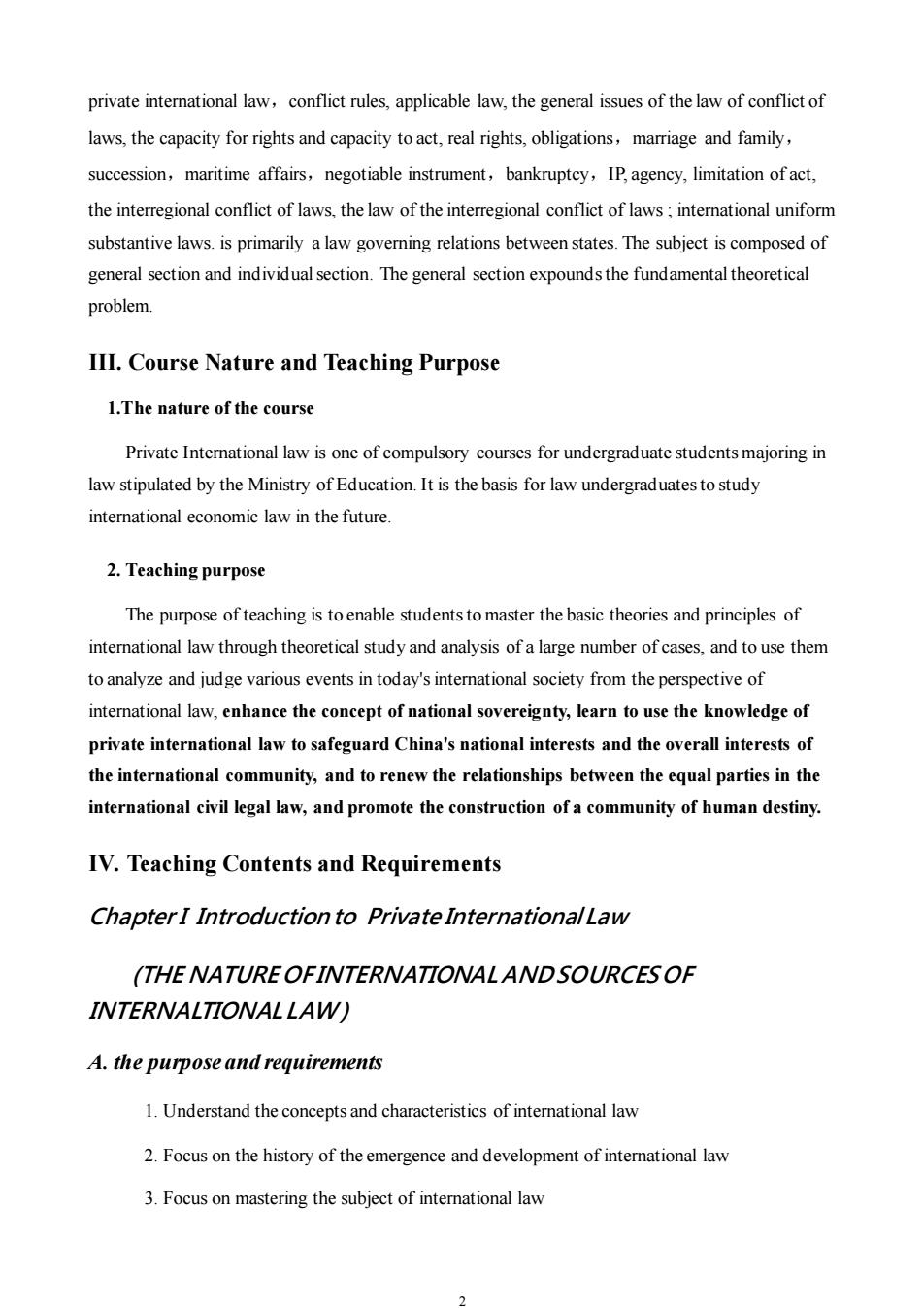
private international law,conflict rules,applicable law,the general issues of the law of conflict of laws,the capacity for rights and capacity to act,real rights,obligations,marriage and family, succession,maritime affairs,negotiable instrument,bankruptcy,IPagency,limitation of act the interregional conflict of laws,the law of the interregional conflict of laws;international uniform substantive laws.is primarily a law governing relations between states.The subject is composed of general section and individual section.The general section expounds the fundamental theoretical problem III.Course Nature and Teaching Purpose 1.The nature of the course Private International law is one of compulsory courses for undergraduate students majoring in law stipulated by the Ministry of Education.It is the basis for law undergraduatestostudy international economic law in the future. 2.Teaching purpose The purpose of teaching is toenable studentstomaster the basic theories and principles of international law through theoretical study and analysis of a large number of cases,and to use them to analyze and judge various events in today's interational society from the perspective of international law,enhance the concept of national sovereignty,learn to use the knowledge of private international law to safeguard China's national interests and the overall interests of the international community,and to renew the relationships between the equal parties in the international civil legal law,and promote the construction of a community of human destiny. IV.Teaching Contents and Requirements ChapterI Introduction to Private InternationalLaw (THE NATURE OFINTERNATIONAL ANDSOURCESOF INTERNALTTONAL LAW) A.the purpose and requirements 1.Understand the concepts and characteristics of international law 2.Focus on the history of the emergence and development of international law 3.Focus on mastering the subject of international law
2 private international law,conflict rules, applicable law, the general issues of the law of conflict of laws, the capacity for rights and capacity to act, real rights, obligations,marriage and family, succession,maritime affairs,negotiable instrument,bankruptcy,IP, agency, limitation of act, the interregional conflict of laws, the law of the interregional conflict of laws ; international uniform substantive laws. is primarily a law governing relations between states. The subject is composed of general section and individual section. The general section expounds the fundamental theoretical problem. III. Course Nature and Teaching Purpose 1.The nature of the course Private International law is one of compulsory courses for undergraduate students majoring in law stipulated by the Ministry of Education. It is the basis for law undergraduates to study international economic law in the future. 2. Teaching purpose The purpose of teaching is to enable students to master the basic theories and principles of international law through theoretical study and analysis of a large number of cases, and to use them to analyze and judge various events in today's international society from the perspective of international law, enhance the concept of national sovereignty, learn to use the knowledge of private international law to safeguard China's national interests and the overall interests of the international community, and to renew the relationships between the equal parties in the international civil legal law, and promote the construction of a community of human destiny. IV. Teaching Contents and Requirements Chapter I Introduction to Private International Law (THE NATURE OF INTERNATIONAL AND SOURCES OF INTERNALTIONAL LAW ) A. the purpose and requirements 1. Understand the concepts and characteristics of international law 2. Focus on the history of the emergence and development of international law 3. Focus on mastering the subject of international law
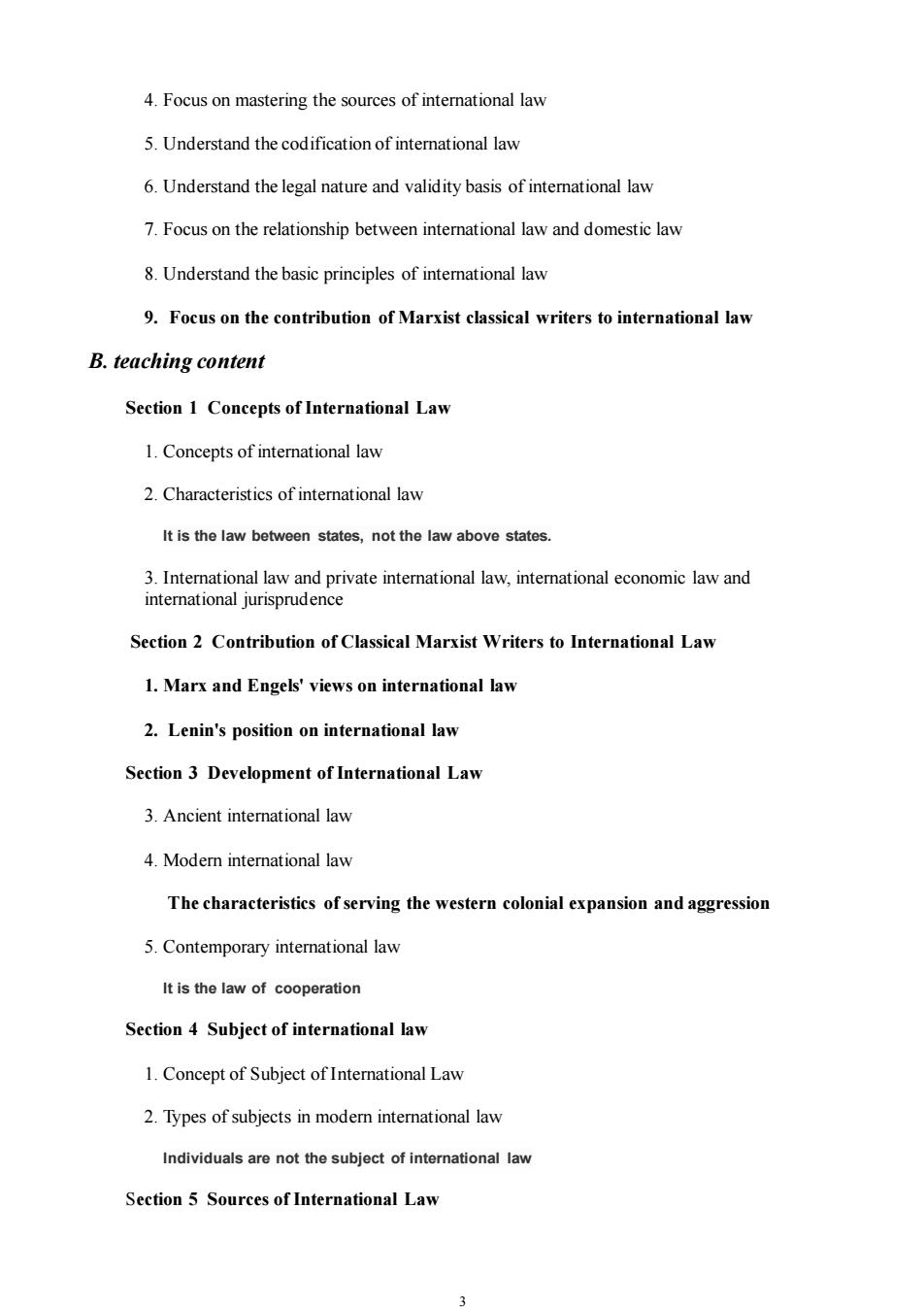
4.Focus on mastering the sources of international law 5.Understand the codification of international law 6.Understand the legal nature and validity basis of intemational law 7.Focus on the relationship between intemational law and domestic law 8.Understand the basic principles of intemational law 9.Focus on the contribution of Marxist classical writers to international law B.teaching content Section 1 Concepts of International Law 1.Concepts of international law 2.Characteristics of interational law It is the law between states,not the law above states 3.International law and private international law,international economic law and international jurisprudence Section 2 Contribution of Classical Marxist Writers to International Law 1.Marx and Engels'views on international law 2.Lenin's position on international law Section 3 Development of International Law 3.Ancient interational law 4.Modem international law The characteristics of serving the western colonial expansion and aggression 5.Contemporary international law It is the law of cooperation Section 4 Subject of international law 1.Concept of Subject of International Law 2.Types of subjects in modern intemational law Individuals are not the subject of international lav Section 5 Sources of International Law
3 4. Focus on mastering the sources of international law 5. Understand the codification of international law 6. Understand the legal nature and validity basis of international law 7. Focus on the relationship between international law and domestic law 8. Understand the basic principles of international law 9. Focus on the contribution of Marxist classical writers to international law B. teaching content Section 1 Concepts of International Law 1. Concepts of international law 2. Characteristics of international law It is the law between states, not the law above states. 3. International law and private international law, international economic law and international jurisprudence Section 2 Contribution of Classical Marxist Writers to International Law 1. Marx and Engels' views on international law 2. Lenin's position on international law Section 3 Development of International Law 3. Ancient international law 4. Modern international law The characteristics of serving the western colonial expansion and aggression 5. Contemporary international law It is the law of cooperation Section 4 Subject of international law 1. Concept of Subject of International Law 2. Types of subjects in modern international law Individuals are not the subject of international law Section 5 Sources of International Law
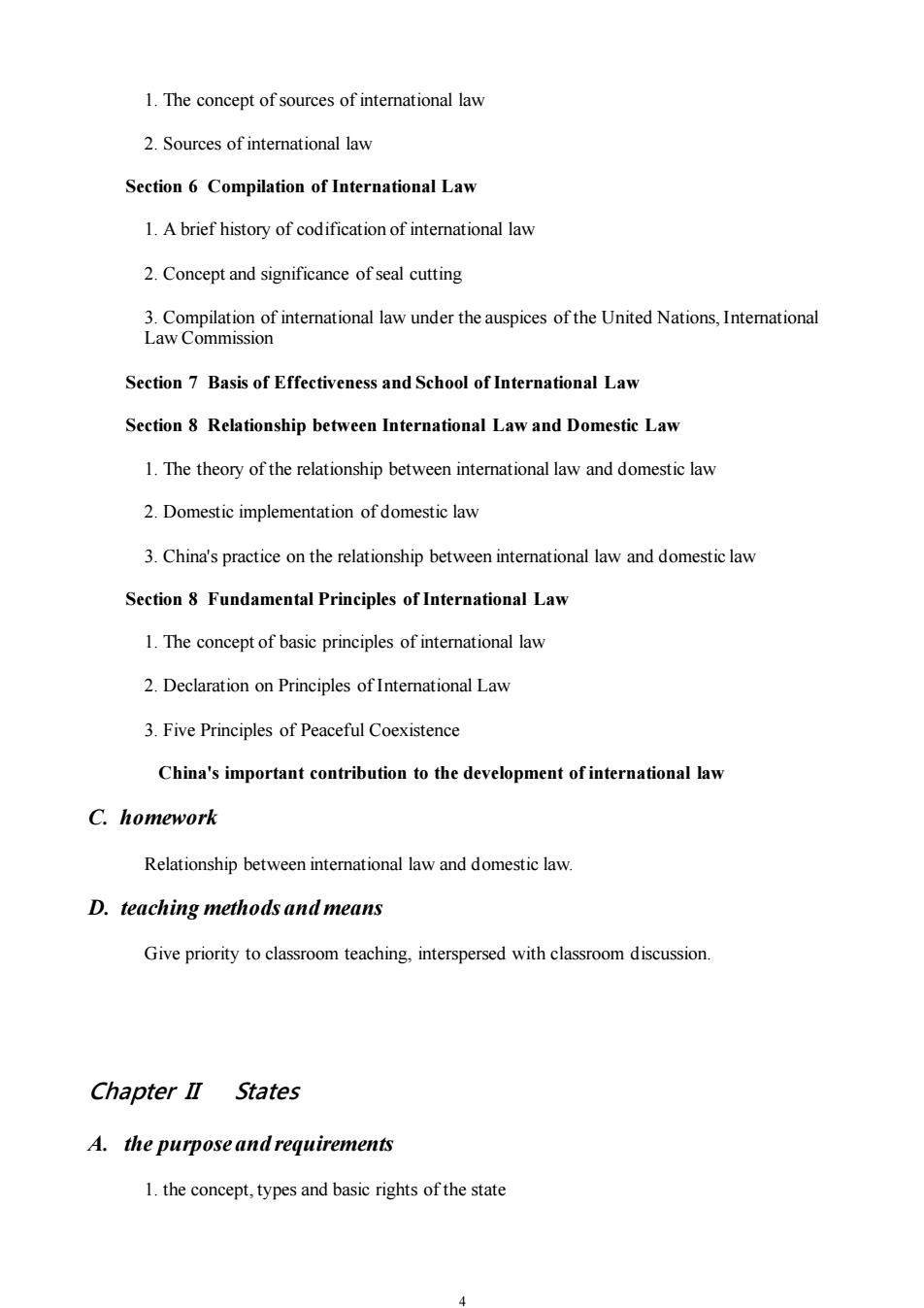
1.The concept of sources of international law 2.Sources of international law Section 6 Compilation of International Law 1.A brief history of codification of international law 2.Concept and significance of seal cutting Section 7 Basis of Effectiveness and School of International Law Section 8 Relationship between International law and Domestic law 1.The theory of the relationship between international law and domestic law 2.Domestic implementation of domestic law 3.China's practice on the relationship between international law and domestic law Section 8 Fundamental Principles of International Law 1.The concept of basic principles of intemational law 2.Declaration on Principles of International Law 3.Five Principles of Peaceful Coexistence China's important contribution to the development of international law C.homework Relationship between interational law and domestic law. D.teaching methods and means Give priority to classroom teaching.interspersed with classroom discussion. ChapterⅡStates A.the purpose and requirements 1.the concept,types and basic rights of the state
4 1. The concept of sources of international law 2. Sources of international law Section 6 Compilation of International Law 1. A brief history of codification of international law 2. Concept and significance of seal cutting 3. Compilation of international law under the auspices of the United Nations, International Law Commission Section 7 Basis of Effectiveness and School of International Law Section 8 Relationship between International Law and Domestic Law 1. The theory of the relationship between international law and domestic law 2. Domestic implementation of domestic law 3. China's practice on the relationship between international law and domestic law Section 8 Fundamental Principles of International Law 1. The concept of basic principles of international law 2. Declaration on Principles of International Law 3. Five Principles of Peaceful Coexistence China's important contribution to the development of international law C. homework Relationship between international law and domestic law. D. teaching methods and means Give priority to classroom teaching, interspersed with classroom discussion. Chapter II States A. the purpose and requirements 1. the concept, types and basic rights of the state

2.Focus on state immunity 3.Understand the difference and effect of recognition between the state and the government 4.Focus on mastering the basic principles of state succession B.teaching content Section 1 Overview of States 1.The concept of state 2.Types of countries The vassal state and the protected state are the types of countries that existed in the past western colonial expansion period 3.Basic rights and obligations of the state 4.State immunity Section 2 Recognition by the state and the government 1.Concept and nature of state recognition To a certain extent,the theory of constitution is conducive to western intervention and control of newly independent countries,and has been abandoned 2.The situation created by the state and the conditions for recognition 3.Mode,scope and effect of state recognition The state has the obligation not to recognize the new state established by violating international law 4.Recognition by Governments and other entities Section 3 State Succession and Government Succession 1.The concept of interational succession 2.Aspects and rules of State succession 3.The People's Republic of China and the question of successior C.homework To analyzes several cases related to the succession ofthe People's Republic of China:the Hubei Ganton Railway Bond Case,the Two Airlines Company Case, and the Guanghualiao Case,and understands the relevant situations in which the
5 2. Focus on state immunity 3. Understand the difference and effect of recognition between the state and the government 4. Focus on mastering the basic principles of state succession B. teaching content Section 1 Overview of States 1. The concept of state 2. Types of countries The vassal state and the protected state are the types of countries that existed in the past western colonial expansion period 3. Basic rights and obligations of the state 4. State immunity Section 2 Recognition by the state and the government 1. Concept and nature of state recognition To a certain extent, the theory of constitution is conducive to western intervention and control of newly independent countries, and has been abandoned 2. The situation created by the state and the conditions for recognition 3. Mode, scope and effect of state recognition The state has the obligation not to recognize the new state established by violating international law 4. Recognition by Governments and other entities Section 3 State Succession and Government Succession 1. The concept of international succession 2. Aspects and rules of State succession 3. The People's Republic of China and the question of succession C. homework To analyzes several cases related to the succession of the People's Republic of China: the Hubei Ganton Railway Bond Case, the Two Airlines Company Case, and the Guanghualiao Case, and understands the relevant situations in which the
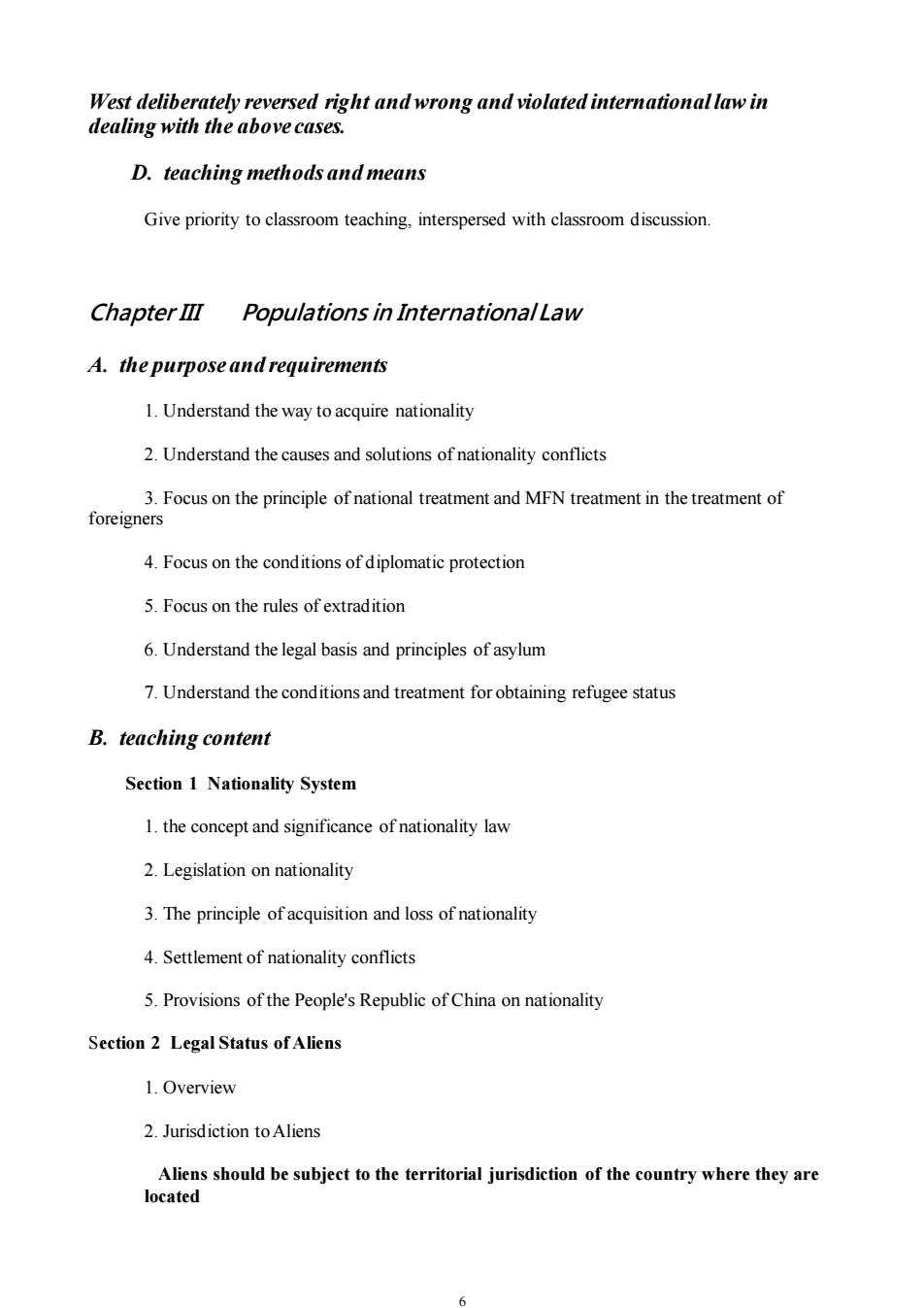
West deliberately reversed right and wrong and violated international law in dealing with the above cases. D.teaching methods and means Give priority to classroom teaching,interspersed with classroom discussion Chapter III Populations in InternationalLaw A.the purpose and requirements 1.Understand the way to acquire nationality 2.Understand the causes and solutions of nationality conflicts 3.Focus on the principle of national treatment and MFN treatment in the treatment of foreigners 4.Focus on the conditions of diplomatic protection 5.Focus on the rules of extradition 6.Understand the legal basis and principles of asylum 7.Understand the conditions and treatment for obtaining refugee status B.teaching content Section 1 Nationality System 1.the concept and significance of nationality law 2.Legislation on nationality 3.The principle of acquisition and loss of nationality 4.Settlement of nationality conflicts 5.Provisions of the People's Republic of China on nationality Section 2 Legal Status of Aliens 1.Overview 2.Jurisdiction toAliens Aliens should be subject to the territorial jurisdiction of the country where they are located
6 West deliberately reversed right and wrong and violated international law in dealing with the above cases. D. teaching methods and means Give priority to classroom teaching, interspersed with classroom discussion. Chapter III Populations in International Law A. the purpose and requirements 1. Understand the way to acquire nationality 2. Understand the causes and solutions of nationality conflicts 3. Focus on the principle of national treatment and MFN treatment in the treatment of foreigners 4. Focus on the conditions of diplomatic protection 5. Focus on the rules of extradition 6. Understand the legal basis and principles of asylum 7. Understand the conditions and treatment for obtaining refugee status B. teaching content Section 1 Nationality System 1. the concept and significance of nationality law 2. Legislation on nationality 3. The principle of acquisition and loss of nationality 4. Settlement of nationality conflicts 5. Provisions of the People's Republic of China on nationality Section 2 Legal Status of Aliens 1. Overview 2. Jurisdiction toAliens Aliens should be subject to the territorial jurisdiction of the country where they are located
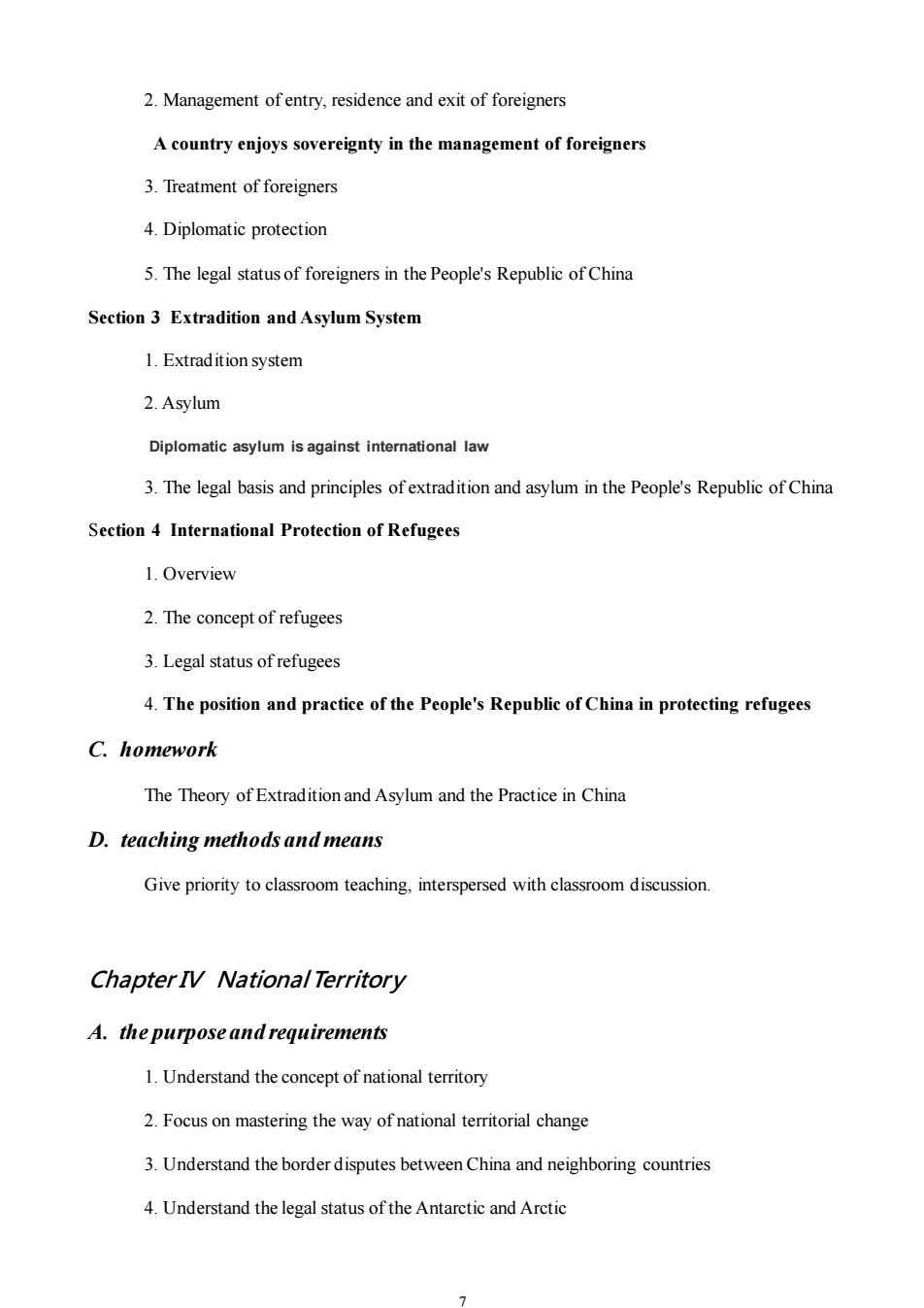
2.Management of entry,residence and exit of foreigners A country enjoys sovereignty in the management of foreigners 3.Treatment of foreigners 4.Diplomatic protection 5.The legal status of foreigners in the People's Republic of China Section 3 Extradition and Asylum System 1.Extradition system 2.Asylum Diplomatic asylum is against international law 3.The legal basis and principles of extradition and asylum in the People's Republic of China Section 4 International Protection of Refugees 1.Overview 2.The concept of refugees 3.Legal status of refugees 4.The position and practice of the People's Republic of China in protecting refugees C.homework The Theory of Extradition and Asylum and the Practice in China D.teaching methods and means Give priority to classroom teaching.interspersed with classroom discussion. Chapter IV National Territory A.the purpose and requirements 1.Understand the concept of national territory 2.Focus on mastering the way of national territorial change 3.Understand the border disputes between China and neighboring countries 4.Understand the legal status of the Antarctic and Arctic
7 2. Management of entry, residence and exit of foreigners A country enjoys sovereignty in the management of foreigners 3. Treatment of foreigners 4. Diplomatic protection 5. The legal status of foreigners in the People's Republic of China Section 3 Extradition and Asylum System 1. Extradition system 2. Asylum Diplomatic asylum is against international law 3. The legal basis and principles of extradition and asylum in the People's Republic of China Section 4 International Protection of Refugees 1. Overview 2. The concept of refugees 3. Legal status of refugees 4. The position and practice of the People's Republic of China in protecting refugees C. homework The Theory of Extradition and Asylum and the Practice in China D. teaching methods and means Give priority to classroom teaching, interspersed with classroom discussion. Chapter IV National Territory A. the purpose and requirements 1. Understand the concept of national territory 2. Focus on mastering the way of national territorial change 3. Understand the border disputes between China and neighboring countries 4. Understand the legal status of the Antarctic and Arctic

B.Teaching content Section 1 State territory and territorial sovereignty 1.the meaning and importance of territory 2.The concept,nature and content ofterritorial sovereignty 3.Restrictions on territorial sovereignty Section 2 Components of State territory 1.Composition of territory 2.Territorial land 3.territorial waters 4.Airspace 5.subsoil Section 3 Ways of changing national territory 1.the meaning of the change of national territory 2.Ways of territorial change in traditional international law Compulsory cession and conquest are considered to violate modern international law 3.Ways of territorial change in modem interational law Section 4 National boundaries and borders 1.The concept of borde 2.The formation and division of borders 3.Settlement of border disputes 4.Border system Section 5 China's territory and borders 1.China's territory 2.China's border China does not recognize the illegal McMahon Line China has sovereignty over the South China Sea Islands and their adjacent waters
8 B. Teaching content Section 1 State territory and territorial sovereignty 1. the meaning and importance of territory 2. The concept, nature and content of territorial sovereignty 3. Restrictions on territorial sovereignty Section 2 Components of State territory 1. Composition of territory 2. Territorial land 3. territorial waters 4. Airspace 5. subsoil Section 3 Ways of changing national territory 1. the meaning of the change of national territory 2. Ways of territorial change in traditional international law Compulsory cession and conquest are considered to violate modern international law 3. Ways of territorial change in modern international law Section 4 National boundaries and borders 1. The concept of border 2. The formation and division of borders 3. Settlement of border disputes 4. Border system Section 5 China's territory and borders 1. China's territory 2. China's border China does not recognize the illegal McMahon Line China has sovereignty over the South China Sea Islands and their adjacent waters
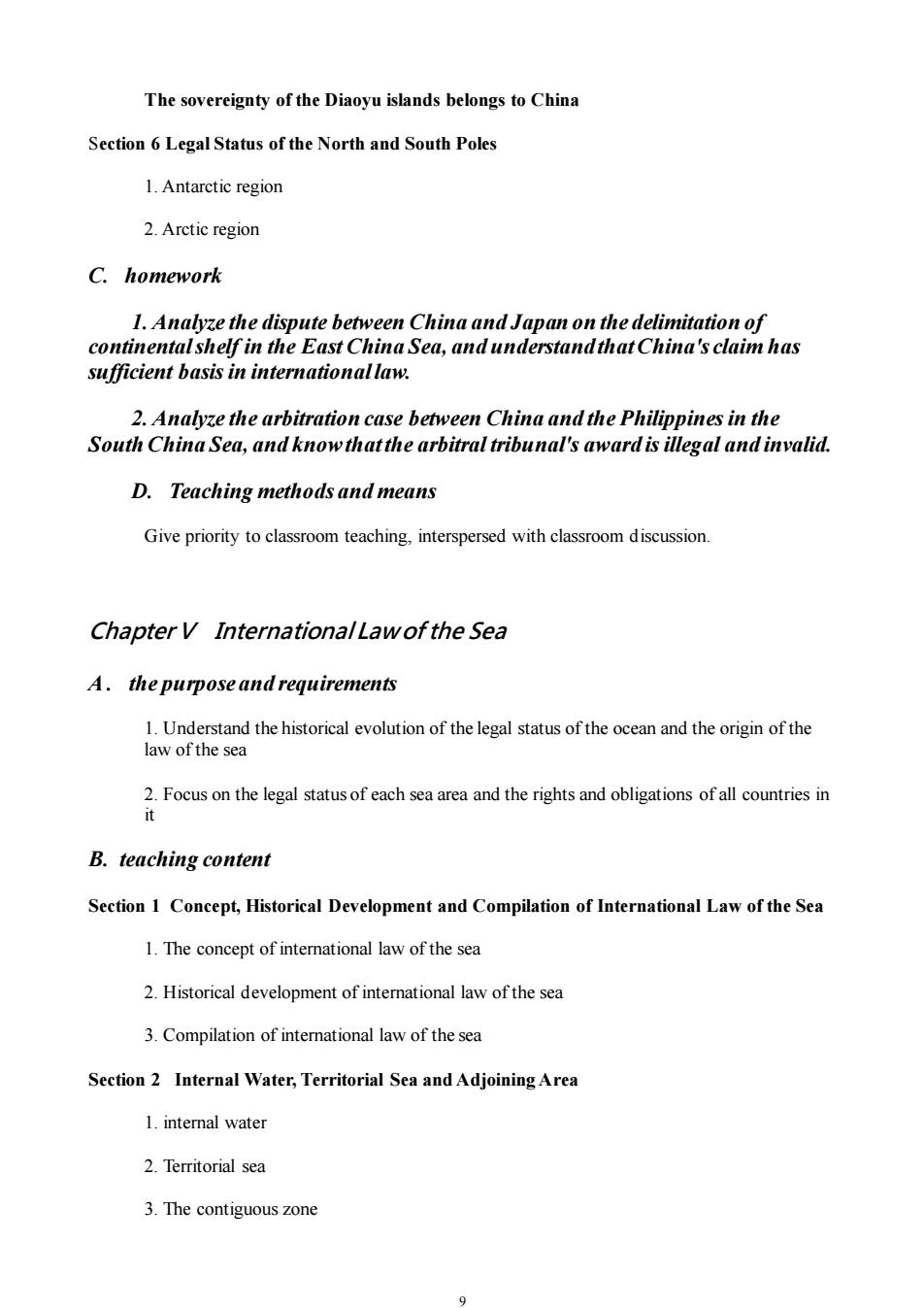
The sovereignty of the Diaoyu islands belongs to China Section 6 Legal Status of the North and South Poles 1.Antarctic region 2.Arctic region C.homework 1.Analyze the dispute between China and Japan on the delimitation of continentalshelf in the East China Sea,and understandthat China's claim has sufficient basis in international law 2.Analyze the arbitration case between China and the Philippines in the South China Sea,and know that the arbitral tribunal's award is illegal and invalid. D.Teaching methods and means Give priority to classroom teaching,interspersed with classroom discussion Chapter V InternationalLawof the Sea A.the purpose and requirements 1.Unde hthesrc evoofhtatus ofthe ocenand the oigin of the B.teaching content Section 1 Concept,Historical Development and Compilation of International Law of the Sea 1.The concept of international law of the sea 2.Historical development of intemational law of the sea 3.Compilation of interational law of the sea Section 2 Internal Water,Territorial Sea and Adjoining Area 1.internal water 2.Territorial sea 3.The contiguous zone
9 The sovereignty of the Diaoyu islands belongs to China Section 6 Legal Status of the North and South Poles 1. Antarctic region 2. Arctic region C. homework 1. Analyze the dispute between China and Japan on the delimitation of continental shelf in the East China Sea, and understand that China's claim has sufficient basis in international law. 2. Analyze the arbitration case between China and the Philippines in the South China Sea, and know that the arbitral tribunal's award is illegal and invalid. D. Teaching methods and means Give priority to classroom teaching, interspersed with classroom discussion. Chapter V International Law of the Sea A . the purpose and requirements 1. Understand the historical evolution of the legal status of the ocean and the origin of the law of the sea 2. Focus on the legal status of each sea area and the rights and obligations of all countries in it B. teaching content Section 1 Concept, Historical Development and Compilation of International Law of the Sea 1. The concept of international law of the sea 2. Historical development of international law of the sea 3. Compilation of international law of the sea Section 2 Internal Water, Territorial Sea and Adjoining Area 1. internal water 2. Territorial sea 3. The contiguous zone
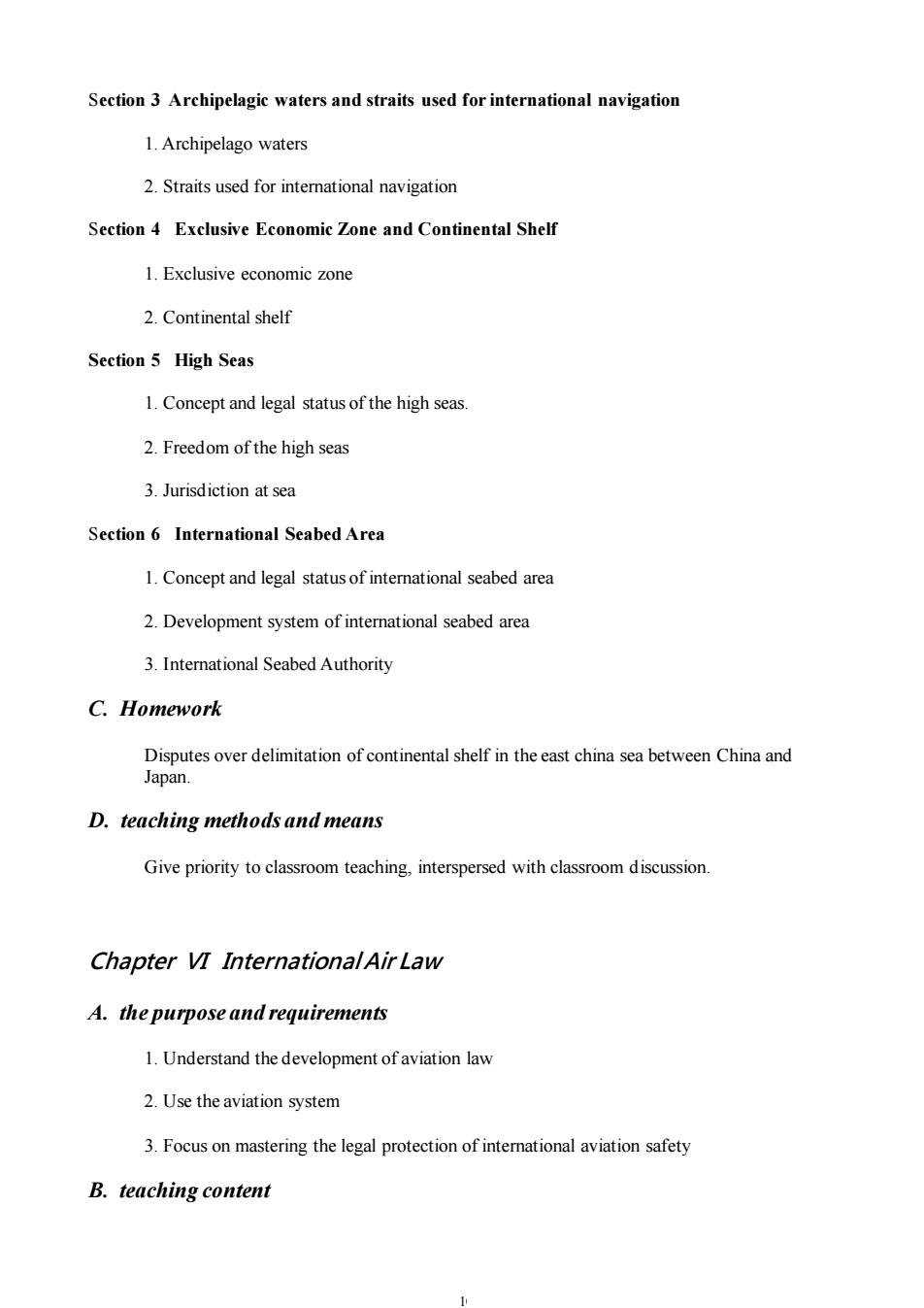
Section 3 Archipelagic waters and straits used for international navigation 1.Archipelago waters 2.Straits used for international navigation Section 4 Exclusive Economic Zone and Continental Shel 1.Exclusive economic zone 2.Continental shelf Section 5 High Seas 1.Concept and legal status of the high seas. 2.Freedom ofthe high seas 3.Jurisdiction at sea Section 6 International Seabed Area 1.Concept and legal status of international seabed area 2.Development system of international seabed area 3.International Seabed Authority C.Homework Disputes over delimitation of continental shelf in the east china sea between China and Japan. D.teaching methods and means Give priority to classroom teaching,interspersed with classroom discussion. Chapter VI InternationalAir Law A.the purpose and requirements 1.Understand the development of aviation law 2.Use the aviation system 3.Focus on mastering the legal protection of international aviation safety B.teaching content
10 Section 3 Archipelagic waters and straits used for international navigation 1. Archipelago waters 2. Straits used for international navigation Section 4 Exclusive Economic Zone and Continental Shelf 1. Exclusive economic zone 2. Continental shelf Section 5 High Seas 1. Concept and legal status of the high seas. 2. Freedom of the high seas 3. Jurisdiction at sea Section 6 International Seabed Area 1. Concept and legal status of international seabed area 2. Development system of international seabed area 3. International Seabed Authority C. Homework Disputes over delimitation of continental shelf in the east china sea between China and Japan. D. teaching methods and means Give priority to classroom teaching, interspersed with classroom discussion. Chapter VI International Air Law A. the purpose and requirements 1. Understand the development of aviation law 2. Use the aviation system 3. Focus on mastering the legal protection of international aviation safety B. teaching content